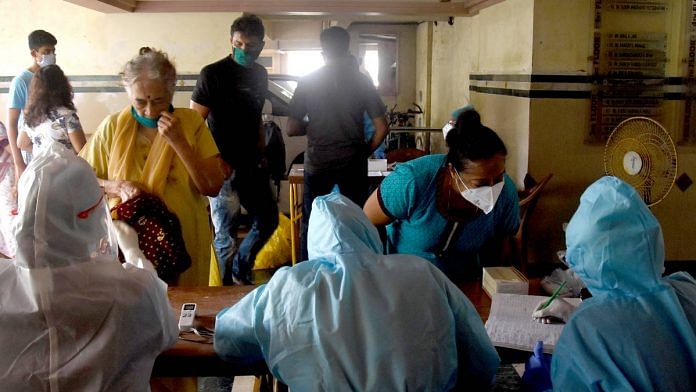Mumbai: Covid-19 testing in Maharashtra has increased more than seven times since June, but the cumulative positivity rate has also inched up to almost 20 per cent from 15 per cent then, suggesting an extensive spread of the infection in the state.
As on 19 August, Maharashtra had a cumulative positivity rate of 19.91 per cent, with a total 33,43,052 tests, according to the state government’s daily bulletin. The increase in tests since 1 June is almost 608 per cent, when the total number was 4,72,344, and the positivity rate was 15.44 per cent.
Government officials and experts ThePrint spoke to said this indicates the infection has spread at a far swifter rate. However, more testing has meant catching infections at an early stage, and that has translated to better recovery figures.
In all, Maharashtra has recorded 6,15,477 Covid cases, of which 4,37,870, or 71 per cent, have recovered, far more than the corresponding percentage of 43 on 1 June.
Also read: Bihar improves testing but still among the lowest 5, Maharashtra’s positivity rate rises
Sero surveys in Mumbai & Pune
The two serological surveys conducted in Maharashtra so far, in Mumbai and Pune, have also indicated a substantial spread of Covid-19. The Mumbai survey showed the presence of antibodies in 57 per cent of the sampled slum population and 16 per cent of those tested from city’s buildings.
The Pune survey showed that more than 51 per cent of samples had been infected by the novel coronavirus.
Dr Subhash Salunkhe, public health expert and chairman of the Maharashtra Communicable Diseases Prevention and Control Technical Committee, said, “Even if the sample size was small, the sero survey results give us an idea of the spread of the infection. If Pune has a 50 per cent spread, at least 25 lakh people should be tested in the city, which may not be practical.”
Salunkhe added, “When we know that the spread of the infection has been so extensive, the testing needs to be more targeted now. There should be a focus on co-morbid patients, symptomatic persons and senior citizens who are among the most vulnerable. The right kind of testing will lead to early detection of positivity, which will help curb the death rate.”
Positivity high as ‘right people being tested’
Nidhi Choudhari, collector of Raigad district, which has the state’s highest positivity rate at 31.7 per cent, said the figure is high because the administration is focusing on targeted testing, though Indian Council of Medical Research guidelines have “democratised” testing.
“We aren’t testing everyone on the streets. Antigen tests are crucial and expensive resources, and the likelihood of finding infections among super spreaders and being able to control the spread is high. So, we are focusing on gram panchayat workers, bus drivers, ASHA and anganwadi workers, civic staff, vegetable vendors and so on,” Choudhari said, adding that Raigad’s proximity to hotspots Mumbai, Pune and Thane and the devastation caused by Cyclone Nisarga fuelled the spread of Covid.
Raigad has conducted about 75,000 tests in total in the 158 days since the first case. Its daily testing rate is about 2,400 per day, compared to just 400 a month ago.
“When testing increases, so does the positivity rate. But then there is a stage when the active cases stagnate despite higher tests, and the number of new cases and discharges are almost the same,” Choudhari explained.
“We are at the juncture now. From here on, the positivity rate will stagnate for a few days before it starts to dip,” he predicted.
More people-to-people contact
Suraj Mandhare, collector of Nashik district, which is also among Maharashtra’s leaders in positivity rate with 25.16 per cent, said the infection has spread after the lockdown was relaxed from June, as there’s more people-to-people contact.
“When our testing numbers were low, we were under a complete lockdown, and people were home and the spread of the infection was low. Now the infection is rising more steadily than tests,” Mandhare said.
Nashik was conducting about 300 tests a day in June, but the number has risen to 2,200 a day now, the collector said. However, he did add that the positivity rate should not be seen as an isolated parameter.
More testing has also led to the diagnosis of more asymptomatic cases — 65 per cent now compared to 45 per cent in June — as well as a lower death rate of 1.7 per cent compared to around 5 per cent then.
Also read: Mumbai’s 5.5% Covid mortality rate a concern, officials say slums better off than high-rises






